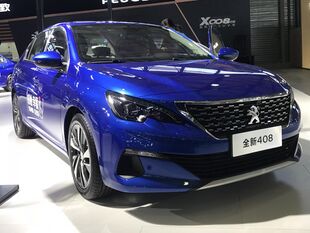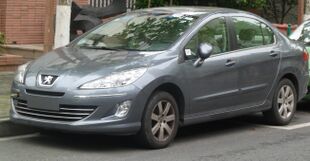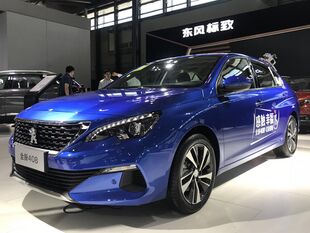Engineering:Peugeot 408
| Peugeot 408 | |
|---|---|
 Peugeot 408 | |
| Overview | |
| Manufacturer | Peugeot |
| Production | 2010–present |
| Body and chassis | |
| Class | Compact car (C) |
| Body style | 4-door saloon |
| Layout | Front-engine, front-wheel-drive |
| Related | Peugeot 308 |
| Chronology | |
| Predecessor | Peugeot 307 saloon Peugeot 407 |
The Peugeot 408 is a compact car (C-segment) produced by Peugeot. It was unveiled on January 25, 2010,[1] at the Beijing Auto Show and sales began in China on April 8, 2010.[2] In November 2010, production of the 408 commenced in El Palomar, Buenos Aires, Argentina,[3] with sales starting in April 2011.
Despite its name, it is not a direct successor to the Peugeot 407, but rather a long-wheelbase saloon version of the Peugeot 308 hatchback,[4] primarily targeted at emerging markets such as China .[5] The 408 is not slated for the Western European market, and not built there.
First generation (T7; 2010)
| First generation | |
|---|---|
 | |
| Overview | |
| Production | 2010–2021 |
| Assembly | Argentina: El Palomar (PSA Argentina) China: Wuhan (DPCA) Malaysia: Gurun (NAM) Russia: Kaluga (PCMA Rus) |
| Body and chassis | |
| Platform | PSA PF2 platform |
| Related | Peugeot 308 Dongfeng Fengshen L60 |
| Powertrain | |
| Engine | 1.6 L TU5JP4 I4 Petrol 1.6L Prince Turbo I4 petrol 2.0 L EW10A+ I4 Petrol 1.6L DV6 HDi I4 diesel |
| Power output |
|
| Transmission | 5-speed Manual 6-speed EAT6 Automatic |
| Dimensions | |
| Wheelbase | 2,710 mm (106.7 in) |
| Length | 4,680 mm (184.3 in) |
| Width | 1,815 mm (71.5 in) |
| Height | 1,525 mm (60.0 in) |
| Chronology | |
| Predecessor | Peugeot 307 saloon |
The 408 was available in China with either a 1.6 L and 2.0 L petrol four cylinder engine. The 1.6 (TU5JP4) has a capacity of 1587 cc and produces 110 bhp (82 kW; 112 PS) at 5,750 r.p.m. and maximum torque of 147 N⋅m (108 lb⋅ft) at 4,000 rpm. The 2.0 L(EW10A+) engine has a capacity of 1997 cc and produces 147 bhp (110 kW; 149 PS) at 6,000 rpm and 200 N⋅m (148 lb⋅ft) at 4,000 rpm.[6]
Either engine can be specified with a five speed manual or four speed automatic transmission.
In South America a 1.6 L diesel engine, known as a HDi (Allure, Feline/Griffe), is sold alongside the 2.0 L petrol engine (Allure, Feline/Griffe) and 1.6L THP petrol engine (Sport) with six speed automatic transmission. The four cylinder diesel has a capacity of 1560 cc and produces 143 bhp (107 kW; 145 PS) and torque of 240 N⋅m (177 lb⋅ft).
The HDi has a top speed of 188 km/h (116.8 mph) and accelerates to 100 km/h (62 mph) in 12.4 seconds.[7]
In Malaysia, 408 comes with two engines, 1.6L Prince turbo engine and 2.0L petrol four cylinder engine. The 1.6L engine produces 163 bhp (122 kW; 165 PS) at 6,000 rpm. and maximum torque of 240 N⋅m (177 lb⋅ft) from 1,400 rpm.
The 2.0 L (EW10A+) engine has a capacity of 1997 cc and produces 145 bhp (108 kW; 147 PS) at 6,000 rpm and 200 N⋅m (148 lb⋅ft) at 4,000 rpm. 1.6L Prince turbo engines mated with six speed and 2.0L engine mated with four speeds auto adaptive gearbox with Tiptronic and Sport mode only.
The first generation 408 continued in production in Latin America and Russia, with multiple facelifts and minor changes. Production in Argentina was halted in 2021.
Second generation (T9; 2014)
| Second generation | |
|---|---|
 2018 Peugeot 408 II (China) (facelift) | |
| Overview | |
| Also called | Dongfeng Fukang ES600 (electric)[8] |
| Production | 2014–present 2016–2018 (Malaysia) |
| Assembly | China: Wuhan (DPCA) Malaysia: Gurun (NAM) |
| Body and chassis | |
| Body style | 4-door saloon |
| Platform | PSA EMP2 platform |
| Related | Peugeot 308 |
| Powertrain | |
| Engine | |
| Transmission | 6-speed automatic |
| Dimensions | |
| Wheelbase | 2,730 mm (107.5 in) |
| Length | 4,750 mm (187.0 in) |
| Width | 1,820 mm (71.7 in) |
| Height | 1,488 mm (58.6 in) |
| |uk|Kerb|Curb}} weight | 1,420 kg (3,130.6 lb) |
The second generation Peugeot 408 was unveiled in the 2014 Beijing Auto Show. In June 2016, the international version of the Peugeot 408 (known as Peugeot 408 e-THP) was launched in Malaysia, though with only one engine choice and transmission. The second generation 408 launched in China is powered by a range of engine options including a 1.8-litre engine producing 139 hp, a 1.2-litre turbo engine with 136 hp, and 1.6-litre turbo engine with 167 hp. All engines are mated with a 6-speed automatic transmission, with a 6-speed manual transmission option also available for the 1.8-litre and 1.2-litre engines.[9]
2018 facelift
A facelift was launched in 2018, featuring a redesigned front fascia, rear bumper, and tail lamps. Powertrain is carried over from the pre-facelift model.[9]
2022 facelift (China)
Another facelift for the 408 was revealed for the Chinese market in June 8 2022. The front end is completely changed to reflect the same design language as the third generation Peugeot 308.[10] The boot is redesigned as well, featuring new graphics and taillights reminiscent of the thrid generation 308 ones.
Third Generation (Crossover, 2022)
The third generation of the Peugeot 408 was revealed in June 2022.[11] It transforms from a traditional sedan (saloon) into a fastback crossover,[12] similarly to the new Citroën C5 X, and will be sold simultaneously with the 2nd generation facelifted sedan in China. It will be produced in France and China, and initally available in Europe in 2023.
Because it is a crossover between a hatchback, a sedan (saloon) and an SUV, it sits higher than the Peugeot 308, has a sloping silhouette and a hatchback tailgate.[13] It will initially be available with a 130bhp petrol engine and two petrol plug-in hybrids, with 180bhp and 225bhp. An all electric version will come in the following months.[11]
References
- ↑ "408 in Beijing". Peugeot. 2010-01-25. http://www.peugeot.com/en/news/2010/1/25/408-in-beijing.aspx.
- ↑ "Commercial launch of the Peugeot 408 in China". Peugeot. 2010-04-09. http://www.peugeot.com/en/news/2010/4/9/commercial-launch-of-the-peugeot-408-in-china.aspx.
- ↑ "Automotive World 9 November 2010". Automotiveworld.com. 2010-11-09. http://www.automotiveworld.com/news/manufacturing/84590-argentina-psa-launches-peugeot-408-build.
- ↑ New Peugeot 408 launched Autocar 25 January 2010
- ↑ Commercial launch of the Peugeot 408 in China - Peugeot Press Release, 8 Apr 2010
- ↑ "Peugeot 408 press kit January 2010" (PDF). http://www.peugeot.com/media/905323/408_1001infopresse_en.pdf.
- ↑ "Peugeot Argentina website". Peugeot.com.ar. http://www.peugeot.com.ar/versiones408.
- ↑ "The Dongfeng Fukang ES600 Is A 2014 Peugeot 408 With An Electric Powertrain" (in en-US). 2022-01-11. https://www.carscoops.com/2022/01/the-dongfeng-fukang-es600-is-a-2014-peugeot-408-with-an-electric-powertrain/.
- ↑ 9.0 9.1 "Peugeot 408 sedan has been updated. First photos" (in en-US). 2021-02-15. https://tidingsauto.com/23452-peugeot-408-sedan-has-been-updated-first-photos/.
- ↑ "将于6月亮相 全新一代标致408预告图" (in zh). 2022-05-26. https://www.autohome.com.cn/news/202205/1248183.html.
- ↑ 11.0 11.1 "NEW PEUGEOT 408 : A NEW BREED OF PEUGEOT". 2022-06-26. https://www.media.stellantis.com/em-en/peugeot/press/new-peugeot-408-a-new-breed-of-peugeot-a-dynamic-fastback-unexpected-from-every-angle.
- ↑ "NEW PEUGEOT 408: THE UNEXPECTED" (in en). https://www.media.stellantis.com/em-en/peugeot/press/new-peugeot-408-the-unexpected.
- ↑ "New Peugeot 408 saloon-SUV to gain full electric version | Move Electric". https://www.moveelectric.com/e-cars/new-peugeot-408-saloon-suv-gain-full-electric-version.
External links
- Peugeot 408 (in Chinese)






